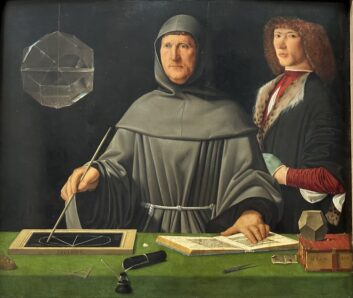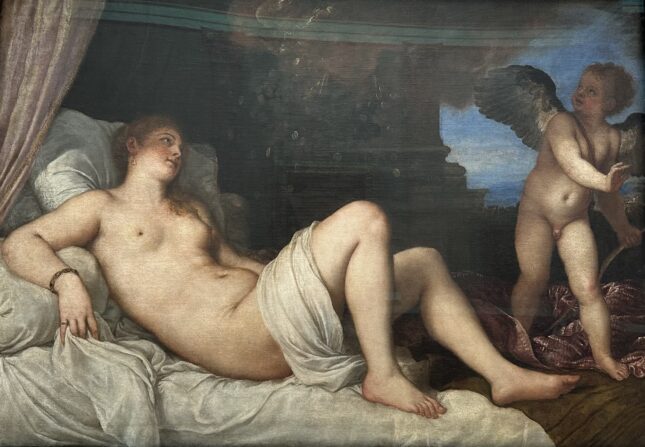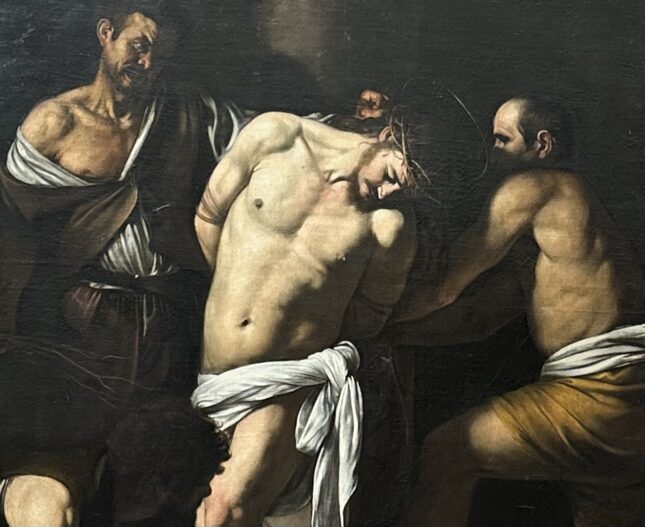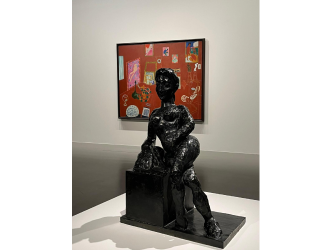La Grande Galerie
How long has it been since you walked through the permanent collections, the holy of holies at the Louvre, the Grande Galerie? Across 460 metres stretches a display of one of the grandest episodes in the history of art, bringing together an ensemble of gems from the Italian Renaissance. Until 8 January the famous institution is offering the unmissable opportunity to revisit this era. (See here the last report about Le Louvre).
Capodimonte, Naples
It is showcasing a Grande Galerie that has been enriched even further, because the Louvre has entered into collaboration with one of the richest museums in Italy, the Capodimonte in Naples (49,000 works). The Grande Galerie, along with the Salon Carré et the Salle de l’horloge, are hosting 70 artworks from Naples in dialogue with their own collections. For the occasion, as Sébastien Allard – head of paintings at the Louvre – explains, the entire layout has been revised.
Naples à Paris

Caravaggio, Sebastien Allard
Thanks to this encounter, baptized “Naples à Paris”, these works have been cast, for the most part, in a completely new light. The same can be said of the bringing together of an extraordinary ensemble of portraits as conceived by the Renaissance.
Mystery

Jacopo de Barbari
In 1495, under the paintbrush of a certain Jacopo de Barbari, a mathematician by the name of Luca Pacioli is celebrated with a touch of mystery. The serious-looking priest, who is reading and drawing at the same time, is overlooked by a glass polyhedron, an illustration of his skill in geometry. He is known as the author of a work on “Divine Proportions”, a subject that preoccupied the entire artistic circle at the time.
Rosso Fiorentino influencing Delacroix

Rosso Fiorentino
Even while this is not a novelty, since it is on permanent display in Paris, we delight in this new positioning in front of the Mannerist composition by the Italian artist who lived in France, Rosso Fiorentino. He has left us his Pieta, made around 1530. Christ is depicted with his face darkened by death, surrounded by an agglomeration of figures, including a Mary with a luscious mouth who lifts her arms to the sky in suffering. Delacroix must have observed this panel in detail, since it is not unlike his own Pieta, on view today in a church in the Marais district, Saint Denys du saint Sacrement.

Eugène Delacroix (Saint Denys du saint Sacrement)
The cardinals were sensual
The must-see of the visit can be found at the centre of the gallery, in what the specialists call “la tribune” marked by eight columns. Two paintings of immense sensuality have been placed face to face and they both belonged to… cardinals.

Titian
On one side there is a Danaé who is all flesh, lounging on her bed while Jupiter falls from the sky in the form of pieces of gold. This creature, conjured up by the Venetian master Titian, is the mother of all the Olympias, Majas, and other languid Venuses from ancient and modern painting. It was created specially for Cardinal Alexandre Farnèse. And on the other side there is a “Venus and Cupid with a Satyr” from the hand of the Parma native, Correggio, which belongs to the Louvre. This nude woman who offers herself up to sleep was the property of Cardinal de Mazarin.
Caravaggio’s “Flagellation”

Caravaggio (detail)
Other moments of major impact define this rearrangement of artworks. We can cite Caravaggio’s “Flagellation” in which a Christ with a sublimely muscular body is curved over, awaiting his legendary suffering. Caravaggio, fleeing his judges after having been accused of a crime, spent 18 months in Naples. It was there that he painted this canvas measuring 2.8 metres, conceived for a private chapel. We are struck walking through the Grande Galerie by the very modern preoccupation, yet one which is shared by all these artists, of depicting movement in paint. mIchelangelo
Lastly, no visit is complete without going to the Salle de l’horloge on the upper floor to see a preparatory drawing (known as a “cartoon”) for a fresco made by Michelangelo.
Beasts of war
The huge charcoal piece (2.6 metres tall) depicts a group of soldiers from behind for a composition made in the Pauline Chapel at the Vatican. The mastery in the representation of volume here produces an effect of bas-relief. These men were imagined to be like beasts of war, at the same time powerful yet graceful. Mind-blowing genius.

Michelangelo
Naples à Paris. Le Louvre invite le musée de Capodimonte. Until 8 January. www.louvre.fr/en-ce-moment/expositions/naples-a-paris
Support independent news on art.
Your contribution : Make a monthly commitment to support JB Reports or a one off contribution as and when you feel like it. Choose the option that suits you best.
Need to cancel a recurring donation? Please go here.
The donation is considered to be a subscription for a fee set by the donor and for a duration also set by the donor.




